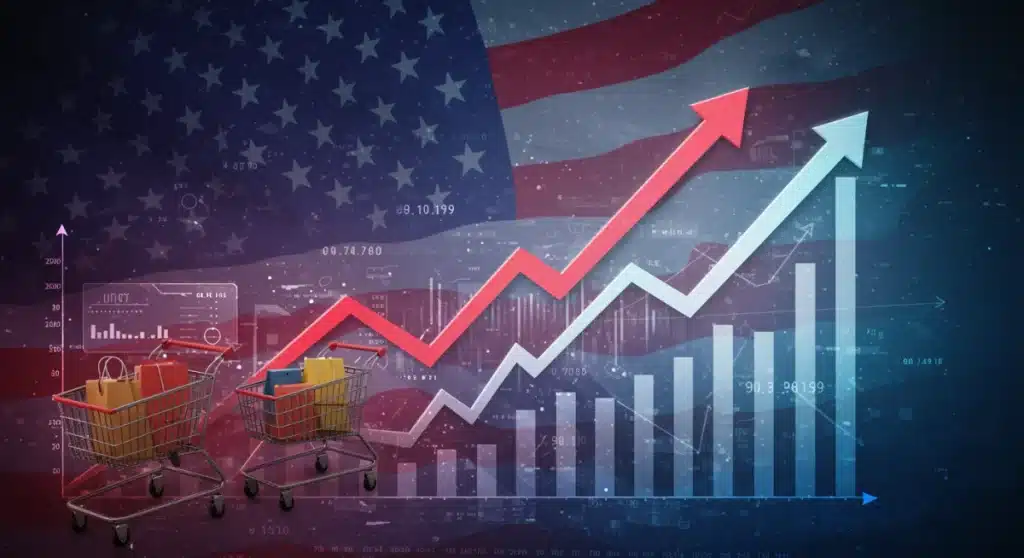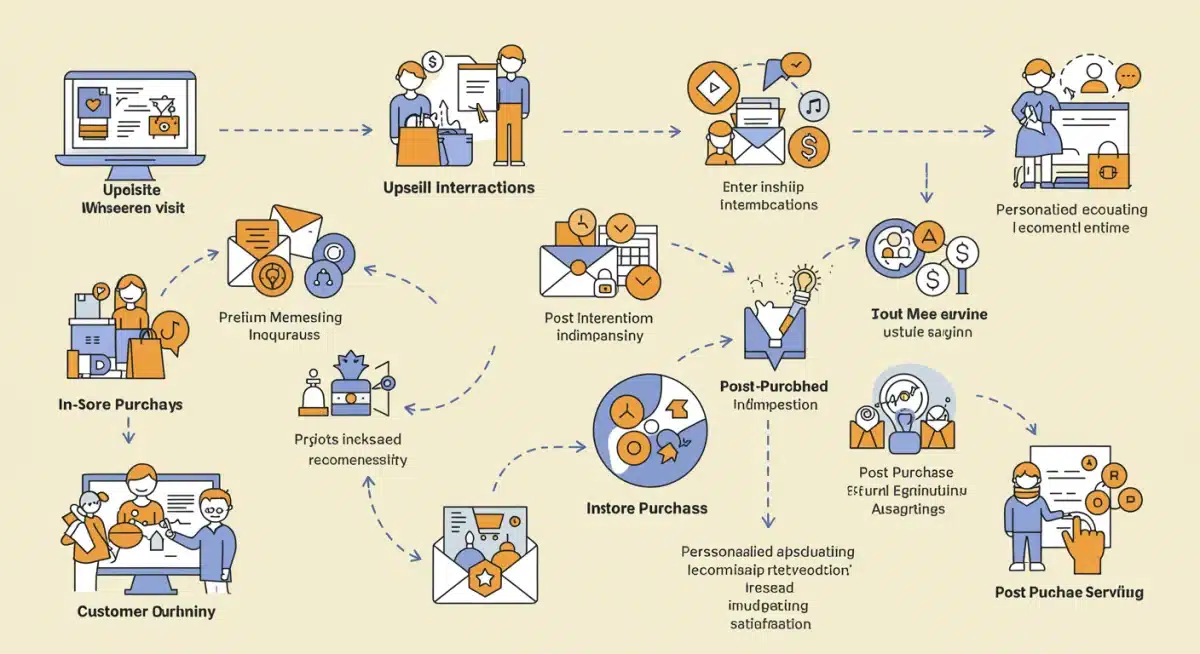Boosting Your Bottom Line: AOV Strategies for US E-commerce

US e-commerce businesses are actively seeking innovative strategies to significantly increase their average order value (AOV) by 25% in 2025, directly impacting their financial bottom line and fostering sustainable growth amidst evolving market dynamics.
Boosting Your Bottom Line: How US E-commerce Businesses Can Increase Average Order Value by 25% in 2025 (FINANCIAL IMPACT) is a critical objective for many online retailers. As of late 2024, the competitive landscape and evolving consumer behaviors necessitate a proactive approach to maximizing revenue per transaction. This report delves into actionable strategies and current market trends poised to deliver substantial AOV growth.
Understanding the Current E-commerce Landscape
The US e-commerce sector continues its rapid evolution, marked by shifting consumer expectations and technological advancements. Businesses are grappling with increased acquisition costs, making the optimization of existing customer value paramount. Understanding these dynamics is the first step toward significant AOV improvements.
Recent data indicates a slight softening in consumer spending in specific discretionary categories, as reported by industry analysts last week. This development underscores the urgency for e-commerce platforms to refine their sales tactics, moving beyond simple transaction volume to focus on the value derived from each customer interaction. The emphasis is now squarely on enhancing the financial impact of every sale.
Key Market Trends Influencing AOV
Several major trends are currently shaping the potential for AOV growth. Personalization, driven by AI and machine learning, is no longer a luxury but a necessity for engaging modern consumers. The rise of mobile commerce also demands optimized experiences that facilitate larger purchases on smaller screens.
- AI-Powered Personalization: Leveraging AI to offer highly relevant product recommendations has shown a direct correlation with increased basket sizes, as highlighted by a recent study from Salesforce.
- Subscription Models: The growth of recurring revenue models, from curated boxes to essential replenishments, inherently boosts customer lifetime value and often AOV by encouraging regular, bundled purchases.
- Seamless Mobile Experience: A frictionless mobile checkout process and intuitive product discovery on smartphones are crucial for preventing cart abandonment and encouraging additional item selection.
Strategic Upselling and Cross-Selling Techniques
Upselling and cross-selling remain foundational pillars for enhancing average order value. However, their execution in 2025 demands sophistication and data-driven insights. It’s about presenting relevant additions and upgrades that genuinely enhance the customer’s primary purchase, rather than merely pushing more products.
Effective implementation hinges on understanding customer intent and purchase history. According to a recent report from McKinsey & Company, businesses that personalize their upselling and cross-selling efforts see, on average, a 10-20% increase in revenue. This highlights the financial impact of moving beyond generic recommendations.
Advanced Recommendation Engines
Modern e-commerce platforms are increasingly utilizing advanced recommendation engines that go beyond ‘customers who bought this also bought that.’ These systems analyze browsing behavior, demographic data, and even external trends to suggest highly compatible products or premium alternatives. The goal is to make the upsell feel like a helpful suggestion, not a sales pitch.
- Bundling Complementary Products: Offering product bundles at a slight discount encourages customers to purchase multiple items they might need together, such as a camera with a lens and carrying case.
- Post-Purchase Offers: Presenting relevant, last-minute add-ons on the confirmation page or via email immediately after purchase can capture additional revenue without interrupting the primary transaction flow.
- Tiered Pricing for Upgrades: Clearly presenting different versions of a product (e.g., basic, premium, deluxe) can entice customers to opt for the higher-priced option when the value proposition is clear.
Optimizing Pricing and Promotions for AOV
Pricing strategies and promotional offers play a pivotal role in influencing average order value. It’s not just about offering discounts, but strategically structuring incentives that encourage customers to spend more. This requires a delicate balance between perceived value and actual profitability.
As reported by industry experts at the E-commerce Growth Summit last week, dynamic pricing models, which adjust prices based on real-time demand and competitor activity, are gaining traction. Such models, when coupled with intelligent promotional campaigns, can significantly impact a business’s bottom line by maximizing revenue per transaction.
Strategic Discounting and Thresholds
Instead of blanket discounts, businesses should consider threshold-based promotions. These encourage customers to add more items to their cart to qualify for a discount or free shipping. For example, ‘Spend $75 and get 15% off’ is more effective for AOV than ‘10% off everything.’
- Free Shipping Thresholds: A classic and highly effective strategy. Setting a free shipping threshold slightly above the current average order value motivates customers to add more items to qualify.
- Bundle Discounts: Offering a discount when customers purchase a predefined set of products, encouraging larger purchases of complementary items.
- Quantity Discounts: Providing a lower per-unit price when customers buy multiple units of the same item, ideal for consumables or frequently purchased goods.
Enhancing the Customer Experience and Loyalty
A superior customer experience doesn’t just foster loyalty; it directly influences average order value. Satisfied customers are more likely to return, spend more, and be receptive to additional offers. Building trust and making the shopping journey effortless are crucial components.
Recent consumer behavior studies, including one published by Forrester in early November, highlight that 73% of customers consider customer experience a key factor in their purchasing decisions. This data underscores that investing in seamless service and personalized interactions has a tangible financial impact on AOV.

Personalized Shopping Journeys
From personalized product recommendations based on past purchases and browsing history to tailored email campaigns and in-app messages, customization makes customers feel valued. This personalized approach not only increases conversion rates but also encourages customers to explore more of what a brand offers, leading to larger baskets.
- Loyalty Programs: Rewarding repeat purchases with points, exclusive discounts, or early access to new products incentivizes customers to consolidate their spending with one brand.
- Exceptional Post-Purchase Support: Prompt and helpful customer service for returns, exchanges, or product inquiries builds trust and encourages future purchases, often at higher values.
- User-Generated Content Integration: Showcasing customer reviews, photos, and videos can build social proof and encourage other shoppers to explore and purchase more confidently.
Leveraging Technology and Data Analytics
In the quest to boost average order value, technology and robust data analytics are indispensable tools. Businesses must move beyond rudimentary tracking to sophisticated analysis that uncovers patterns, predicts behavior, and informs strategic decisions. The financial impact of data-driven insights cannot be overstated.
As reported by industry publication E-commerce Times just two days ago, companies effectively utilizing AI and machine learning for predictive analytics are seeing up to a 15% increase in AOV. This demonstrates the immediate relevance and necessity of integrating advanced technological solutions into operational strategies.
Predictive Analytics for AOV Growth
Predictive analytics allows businesses to forecast customer needs and preferences, enabling proactive upselling and cross-selling. By analyzing vast datasets, algorithms can identify which products are most likely to be purchased together or which premium options a specific customer segment might prefer. This foresight leads to highly targeted and effective offers.
- A/B Testing Product Pages: Continuously testing different layouts, product descriptions, and call-to-action buttons to identify what encourages customers to add more to their cart.
- Basket Analysis: Understanding which products are frequently purchased together to create compelling bundles or cross-sell opportunities.
- Customer Segmentation: Dividing customers into groups based on their purchasing behavior to tailor promotions and product recommendations, maximizing their individual AOV potential.
Forecasting and Future Trends for 2025
As US e-commerce businesses look toward 2025, understanding emerging trends and refining forecasting models are paramount for sustained AOV growth. The landscape is dynamic, with new technologies and consumer behaviors constantly shaping the market. Proactive adaptation will define success.
Analysts from Deloitte recently presented their outlook for 2025, emphasizing the growing importance of immersive shopping experiences, such as augmented reality (AR) and virtual reality (VR), in enhancing product perception and encouraging higher-value purchases. These technologies are expected to have a notable financial impact on average transaction sizes.
Emerging AOV Enhancers
Beyond current best practices, several emerging factors are poised to influence AOV in the coming year. The integration of advanced AI for hyper-personalization, the expansion of ‘buy now, pay later’ (BNPL) options, and the increasing adoption of sustainable and ethical product lines are all expected to play significant roles.
- Immersive Shopping Experiences: AR/VR tools that allow customers to ‘try on’ clothes or visualize furniture in their homes can reduce returns and increase confidence in higher-priced items.
- Social Commerce Integration: Direct shopping capabilities within social media platforms can streamline the purchase path, potentially leading to impulse buys of additional items.
- Flexible Payment Options: Offering solutions like BNPL can make larger purchases more accessible, removing a potential barrier to increasing cart size for many consumers.
| Key Strategy | Brief Description |
|---|---|
| Personalized Upselling | Offer relevant product upgrades or premium versions based on customer data and browsing history. |
| Strategic Bundling | Group complementary products at a slightly reduced price to encourage multiple item purchases. |
| Free Shipping Thresholds | Set a minimum spend for free shipping, motivating customers to add more to their cart. |
| Data-Driven Analytics | Utilize AI and predictive analytics to inform product recommendations and promotional offers. |
Frequently Asked Questions About AOV Growth
Average Order Value (AOV) is the average amount of money spent per customer order. It’s crucial because increasing AOV directly boosts revenue without needing to acquire more customers, significantly impacting profitability and overall financial health for e-commerce businesses.
Personalization, especially through AI-driven recommendations, tailors product suggestions, bundles, and offers to individual customer preferences. This relevance encourages customers to buy more items or higher-priced versions, directly contributing to a substantial AOV increase by making purchases more appealing.
Yes, free shipping thresholds remain highly effective. By setting a minimum spend slightly above the current AOV, businesses motivate customers to add extra items to their cart to qualify for free delivery, thereby increasing the total transaction value. This psychological trigger works consistently.
Data analytics is fundamental for AOV optimization. It allows businesses to understand customer behavior, identify popular product combinations, and predict purchasing patterns. This insight enables the creation of targeted upselling, cross-selling, and promotional strategies that are far more likely to succeed in increasing AOV.
For 2025, e-commerce businesses should monitor immersive shopping experiences (AR/VR), advanced AI for hyper-personalization, and the continued expansion of ‘buy now, pay later’ (BNPL) options. These trends are anticipated to significantly influence consumer spending habits and AOV potential.
Looking Ahead
The drive to increase average order value by 25% in 2025 is not merely an ambitious target but a strategic imperative for US e-commerce businesses. The strategies outlined—from sophisticated personalization and strategic pricing to leveraging advanced analytics and enhancing customer experience—are not isolated tactics but interconnected components of a holistic growth plan. What happens next involves continuous monitoring of consumer trends, rapid adoption of technological innovations, and agile adaptation to market shifts. Businesses that proactively invest in these areas are best positioned to realize substantial financial gains and strengthen their competitive standing in the evolving digital marketplace.